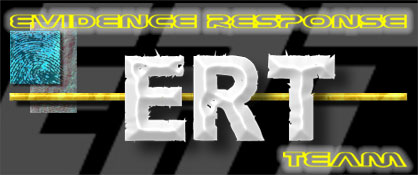
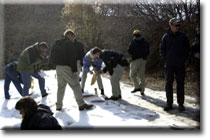 The
Salt Lake City field office (or, division) covers the states of Utah,
Montana, and Idaho, the largest geographical area covered by any FBI field
office in the contiguous United States. The current team composition of
the Salt Lake City Evidence Response Team (ERT), which was formed in 1996,
is nine agents and two support employee in Salt Lake City, and seven agents
and one support employee in the Montana and Idaho Resident Agencies, for
a total of 19 members. One Special Agent serves as point of contact and
team leader for each state. In preparation for the 2002 Olympics, the
Salt Lake City Division ERT is being significantly enhanced by support
from other Divisions' Evidence Response Teams.
The
Salt Lake City field office (or, division) covers the states of Utah,
Montana, and Idaho, the largest geographical area covered by any FBI field
office in the contiguous United States. The current team composition of
the Salt Lake City Evidence Response Team (ERT), which was formed in 1996,
is nine agents and two support employee in Salt Lake City, and seven agents
and one support employee in the Montana and Idaho Resident Agencies, for
a total of 19 members. One Special Agent serves as point of contact and
team leader for each state. In preparation for the 2002 Olympics, the
Salt Lake City Division ERT is being significantly enhanced by support
from other Divisions' Evidence Response Teams.
A Challenging Jurisdiction
The expanse and remoteness of much of the territory outside of
Salt Lake City make a timely response to most crime scenes in
resident agency territory extremely challenging. For example,
it takes more than thirteen hours to drive between Salt Lake
City, Utah, and the Glasgow, Montana, resident agency. Consequently,
ERT members in the Resident Agencies serve as first responders
to crime scenes within their territory and, as a practical matter,
often handle the entire scene themselves.
Because team members are located throughout the three-state Division, the team is not deployed in its entirety except in major cases as determined by the field office's top managers, the Special Agent in Charge or an Assistant Special Agent in Charge. For smaller crime scenes, groups of two or three ERT members are deployed at the request of a squad or resident agency supervisor. ERT members assist and advise the agent in charge of managing the case on how best to collect and preserve the evidence.
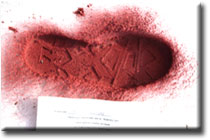 Climatic extremes
are also often a consideration. The cold, snowy winters that
prevail in most of the region require warm, water repellant clothing
and demand specialized evidence collection techniques, such as
the ability to make casts of footprints or tire tracks left in
snow. Summers are hot and dry in southern Utah, sometimes reaching
temperatures in excess of 105 degrees Fahrenheit. ERT personnel
must be prepared to carry water to remote locations and must
wear clothing that will protect them from exposure to the sun.
Climatic extremes
are also often a consideration. The cold, snowy winters that
prevail in most of the region require warm, water repellant clothing
and demand specialized evidence collection techniques, such as
the ability to make casts of footprints or tire tracks left in
snow. Summers are hot and dry in southern Utah, sometimes reaching
temperatures in excess of 105 degrees Fahrenheit. ERT personnel
must be prepared to carry water to remote locations and must
wear clothing that will protect them from exposure to the sun.
Equipment and Training
The Salt Lake City ERT is outfitted with one 14-foot utility trailer that is stocked with crime scene supplies and equipment. A four-wheel drive sport utility vehicle is assigned to the team and pulls the trailer. In addition, an 18-foot utility trailer is maintained by the Salt Lake City Division and stocked with supplies for deployment in the event of a major regional disaster in the Northwest United States.
All team members are volunteers who have elected to perform ERT functions in addition to their normal investigative or support duties. They are motivated by a desire to acquire the forensic skills that will allow them to become specialists in the field of evidence collection. Each member attends an 80 hour basic course which provides instruction in crime scene/evidence photography, latent fingerprint matters, crime scene management/documentation, and general physical evidence recovery matters. Once they have completed the basic course, members are eligible to attend advanced courses covering topics such as recovery of human remains, blood spatter analysis, and post-blast (bombing crime scene) investigations.
Major Cases
Combined Law Enforcement Efforts Catch Kidnappers
On April 19 and 20, 1998, law enforcement agencies in Western Montana participated in a manhunt for kidnapping suspects Walter Eric and Stacy Lyn Weischedel. The Weischedels were wanted in connection with the disappearance of a car salesman from Lewiston, Idaho. After a high speed pursuit by the Montana Highway Patrol and local agencies, the Weischedels fled on foot from the stolen pickup truck they were driving into the mountains in Granite County, south of Philipsburg, Montana. As the result of an extensive two day manhunt, the Weischedels were captured in the area on April 20, 1998.
The capture of the Weischedels enabled investigators and ERT members to locate and retrieve the body of the victim in the area of Evaro, Montana. Through investigation, it was determined that the Weischedels murdered the victim in the commission of stealing the pickup truck while on a test drive. In addition to recovering the victim's body, ERT processed the stolen vehicle and recovered numerous items of evidence. Blood stains were cut out of the upholstery and swabbings were obtained from different parts of the cab's interior. A special vacuum was used to pick up hairs and fibers left by the Weischedels and the victim. The exterior and interior of the pickup truck were powdered and several fingerprints were lifted. Finally, anything left inside the vehicle was collected, photographed, marked for identification and packaged for submission to the FBI Laboratory in Washington, D.C., for further analysis.
As a result of combined efforts on the part of all law enforcement agencies involved, the Weischedels pled guilty to federal charges of kidnapping and interstate transportation of a stolen motor vehicle. After conferring with the victim's family, an agreement was made between the United States Attorney's Office and the Weischedels of a sentence of life in prison without parole.
Preserving the Past
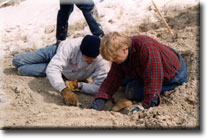 Background: There
are individuals with some knowledge but no formal training in
paleontology who locate dinosaur fossils and remove the largest
pieces for sale to private collectors or museums, usually outside
of the United States. These illegal excavations are carried out
without the benefit of professional recovery techniques or proper
documentation of the specimens and the resulting loss to the
scientific community is devastating.
Background: There
are individuals with some knowledge but no formal training in
paleontology who locate dinosaur fossils and remove the largest
pieces for sale to private collectors or museums, usually outside
of the United States. These illegal excavations are carried out
without the benefit of professional recovery techniques or proper
documentation of the specimens and the resulting loss to the
scientific community is devastating.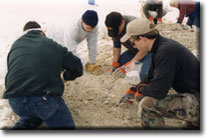
One of the Salt Lake City ERT's more unusual cases involved
the recovery of dinosaur bones. Information regarding the illegal
excavation and sale of dinosaur fossils from federal lands was
brought to the attention of the FBI and the Bureau of Land Management
(BLM) by a retired Utah state paleontologist.
In March of 2001, BLM personnel and ERT members traveled to a remote central Utah location on rugged road, then hiked two miles to a clandestine dinosaur fossil quarry located on federal land. A Global Positioning System (GPS) receiver was used to record the precise location. Assisted by paleontologists, ERT members removed snow cover and stripped away layers of soil in an archeological dig to recover fossil fragments that will be compared to dinosaur bones that were illegally excavated and sold outside the country. The parties responsible for the excavation have been identified and this evidence will be used against them in federal court.
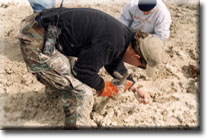
|| ERT Home Page || FBI Laboratory Division || Kosovo - Sorting Clues From The Rubble ||
|| Headquarters and Programs || FBI Home Page ||